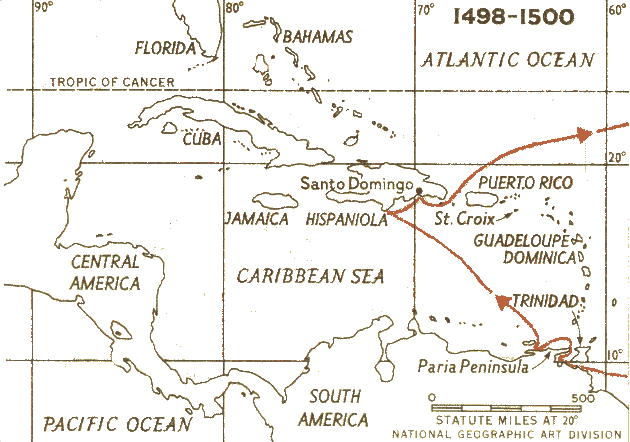
Columbus left the port of Sanlucar in southern Spain on May 30, 1498 with six ships, bound for the New World on his third voyage. After stopping at the islands of Porto Santo and Madeira, the fleet arrived at Gomera in the Canary Islands on June 19. At this point, the fleet split into two squadrons: three ships sailed directly for Hispaniola with supplies for the colonists there; but the other three, commanded by Columbus himself, were on a mission of exploration, attempting to find any lands south of the known islands in the Indies.
The Admiral sailed first to the Cape Verde Islands, where he was unsuccessful in his attempts to obtain cattle. He sailed southwest from the Cape Verdes on July 4, but by the 13th they had made only 120 leagues. At this point, the fleet was becalmed in the Doldrums, an area off the coast of equatorial Africa notorious for its lack of winds.
After drifting eight days in calm and heat, winds returned on the 22nd, and Columbus set their course West. By the morning of July 31 water was running short, so the Admiral decided to steer directly for Dominica, the island he had discovered on his second voyage. After changing course to north by east, the fleet sighted an island in the west at noon that same day. Because the island had three hills, Columbus named it Trinidad, after the Holy Trinity. (Columbus was very devoutly religious).
The fleet obtained water on the south coast of Trinidad, and in the process sighted the coast of South America, the first Europeans to see that continent. Between South America and Trinidad lies the Gulf of Paria, which Columbus explored between August 4th and August 12th. On the morning of the 13th, the fleet sailed out of the Gulf of Paria at its northern entrance and coasted west along the mainland for the next three days, reaching the island of Margarita.
Columbus's health was poor at this time, and he now ordered the fleet to sail for Hispaniola on a northwest by north course. They arrived off southern Hispaniola on August 19, 1498.

Arriving at the new city of Santo Domingo, Columbus discovered that disgruntled colonists had staged a revolt against his rule. Columbus was unable to put down the revolt, and eventually agreed to peace on humiliating terms. But the malcontents continued to grumble, and the amount of gold received from the New World continued to be disappointingly small, both for the colonists and the Sovereigns. Accordingly, Ferdinand and Isabela appointed Francisco de Bobadilla as royal commissioner, with powers above those of Columbus himself. When Bobadilla arrived in Santo Domingo, he immediately had Columbus arrested, and in October of 1500 the Admiral was sent home to Spain in shackles.
![]()
Click here to return to The Columbus Navigation Homepage.